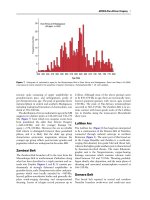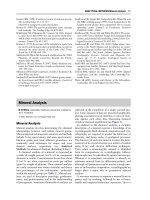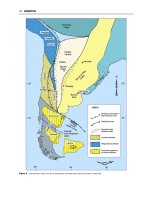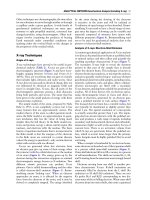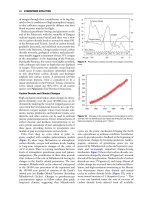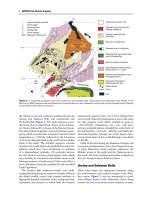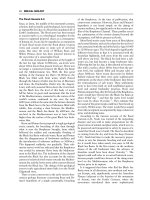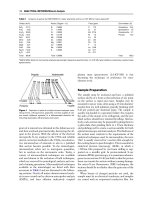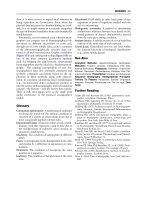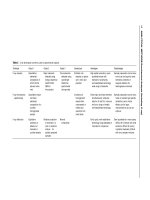Encyclopedia of geology, five volume set, volume 1 5 (encyclopedia of geology series) ( PDFDrive ) 1187
Bạn đang xem bản rút gọn của tài liệu. Xem và tải ngay bản đầy đủ của tài liệu tại đây (53.72 KB, 1 trang )
GAIA 5
had constituted the dominant factor in shaping the
physical development and in controlling the physical
conditions at or near Earth’s surface since life appeared on the planet more than 3500 million years
ago. He found that life had a dominant role in
controlling the condition of the atmosphere through
this immensely long period, and that, in turn, the
surface temperature had a very significant control
on the tectonic evolution, especially plate tectonics.
Even so, Nisbet could not rule as to which processes,
biological or inorganic, had been the dominant
factor – the two kinds of processes had operated
together to control the physical conditions. That
life had exerted a significant effect on the ongoing
physical evolution could not be argued against.
Nisbet based his conclusions on inorganic and organic models, and in them not all the assumptions
made are necessarily correct. For instance, Nisbet
tended to extend plate tectonics back through the
Archaean, whereas there are strong arguments against
this (e.g., see the publications by Hamilton in 1998, by
Bleeker in 2002, and by McCall in 2003). Considering
the real world, rather than models, Nisbet could not
decide which had been in the driving seat, and he believed that the question was possibly not quantifiable.
The atmosphere was, however, largely the product of
the existence of life at or near Earth’s surface.
Beyond Gaia
Gaia, at the least, is a brilliant concept, and Lovelock
has provided a stimulating basis for looking at
the entire globe and for integration of the effects of
the progressive development of life and purely inanimate geological development through time. This concept also encompasses the maintenance throughout
time of conditions suitable for life to continue to exist
throughout 3500 million or more years. However, at
this minimal assessment, it is no more than Earth
System Science under another name, but emphasizing
the special contribution of life to the changing state of
the atmosphere, hydrosphere, and geological processes, which in sum determine the physical conditions under which life of some sort can continue to
‘operate’. The Gaia concept, however, is claimed to be
more than this, and the critical word is ‘regulate’.
Lovelock never intended Gaia to have a teleological
significance, but even so, to regulate something
would seem to imply an element of design. It may be
that when an extreme condition occurs, such as an
extreme greenhouse condition (Cretaceous) or a
‘snowball Earth’ approximation (end Proterozoic),
the reactions of the living plant and animal populations that survive may be beneficial, but equally they
could actually be adverse and eliminate even more of
the global biota. One cannot escape the fact that the
physical state of the near-surface zones of the planet
has, for more than 3500 million years, been sufficiently benign for some life to continue to exist;
throughout the development of life, from protozoans
to destructive humans, the physical state of Earth’s
surface has never led to extinction of the sum total of
life on the planet. Yet the history has surely been one
of reactions by life to changes, including extremely
critical situations, both inorganically and organically
triggered; changes have never reached the point of
driving life over the edge to extinction, but even so,
this is not regulation, because there is no rule involved. The irretrievable end-point situation has just
not happened. In fairness to Lovelock, in his 1991
book he did include a chapter entitled ‘‘The People
Plague’’, in which he argued that humans, having no
predators, had in effect become a plague on the
planet, and could well take the life on the planet to
that irretrievable end-point situation. Of course, one
could argue that humans do have predators, even if
minute ones – viruses and microbes that could blot
them out forever and leave behind an Earth smiling
with other life forms, until the Sun fulfils its destiny
and incinerates the planet.
The influence of the existence of life on the physics
and chemistry near the surface of the planet, and the
feedback to life from that – the essence of Gaia – is
well understood, but has obviously become more
complex as the spectrum of life on Earth has become
more complex, starting with the primitive prokaryotes in the Early Archaean. For example, a plant
population limited to algae must have left bare rock
surfaces in the Archaean, whereas once higher plants
appeared, there must have been a much more complex reaction of the land surface to the Sun’s radiation. In fact, these relationships, though complex
and possibly unquantifiable at the present state of
the planet, are less obscure than are other processes.
For example, how does an animal obtain information
that another animal exists and has a character or
activity to which the first animal can adapt, to obtain
benefit? How does the information get into the genetic process? The present author, in an unpublished
work, The Vendian (Ediacaran) in the Geological
Record, has called this mysterious process ‘cognizance’. An example of this is the case of eoforaminifera found in Uruguay, in latest Proterozoic rocks.
These organisms agglutinated fine mineral particles
on their surface, and it has been glibly said that they
did this to make themselves less palatable to predators. But how did they know that their mates were
being eaten? It would seem that this aspect of genetics
is what scientists should now be concentrating on,
rather than ‘regulation’ by the sum total biota.
